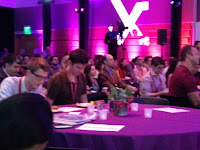That's advice that a respected friend gave me three years ago. Boy, was he ever right.

This was my third experience at Stanford University's Medicine X
http://medicinex.stanford.edu . It was my second as an e-patient. I thought after last year's experience that this year might be a letdown. Boy, was I ever wrong.

Pre-Conference 1 -- "Providers are from Mars, Patients are from Venus: A workshop to improve patient-provider communication."
Faculty and staff of the Stanford Medical School facilitated a workshop that opened eyes to challenges and pitfalls of difficult provider-patient communications today. Actors who work in the medical school gave excellent portrayals of the challenges. I left with hope that healthcare delivery will improve, and I appreciate the insights into the training and challenges of the physician. Thanks to Boehringer Ingleheim for this workshop.
Pre-Conference 2 -- "Shared Decision Making"
Eli Lilly and Company decision science specialists facilitated a workshop centered around a painfully difficult decision that a young couple faced regarding genetic testing and Alzheimer's disease. The process of sorting out the elements of decisions was enlightening. Thanks, Lilly.

And I was certainly glad to learn the California Duck Protocol.
E-patient Dinner
The night before the official start of Medicine X, the e-patient delegates are invited to a group dinner where we met a talented and diverse group of movers and shakers, many of whom are dealing with huge health challenges. It's a special group and I'm grateful to have been included.
Medicine X Day 1

The speakers who work in our government were such refreshing highlights -- truly people who are able and willing to break the bureaucratic ruts that hold us back. Claudia Williams, LaVerne Council, Susannah Fox -- the sharpest tacks in the healthcare toolkit as far as I'm concerned.
And then Eric and Terri Amador came on stage to teach all of healthcare through their ALS experience. And Day 1 was good, so good.
Medicine X Day 2
As distracted as I was over my afternoon Ignite! presentation, it was again a productive day. The
people you meet, the conversations you have, the presentations you didn't expect to attend are all some of the best things about Medicine X.
My Ignite! talk went fine, and I had questions about the clinical trial secret shopper project afterward, and I can't thank Louise Schaper enough for making a challenging 5 minutes fun and bringing out the best in every presenter.
It was a football Saturday at Stanford, and as I walked back to my hotel after a very long day, the campus quiet was almost eerie as tens of thousands of people were consumed with football in a far corner of the campus.
Medicine X Day 3
Just when I thought it couldn't get better, it did. I attended the Million Veteran Project presentation in
the PMI tent. They have half a million veterans' genetic typing completed and histories completed already. They are looking for things to do with this rich set of data.
They are looking at a long list of diseases that are often connected with those who have served in the military -- heart disease, PTSD,... Have they looked at ALS, I asked? They did not know that there is double the incidence of ALS in US military veterans than in the general population. They do now, and it is on their radar. Think of the clues that all of the genomic data may hold related to the ALS-military mystery!
Thank YOU, MVP.
Then I went to a session on the patient-innovation.com project in Portugal. For years we have been wanting a resource where the McGyver hacks that people invent to outsmart ALS can be archived and referenced. Is this it? I think it may be.
Finally I attended a timely session presented by Joe Gulfo on the FDA we need in the 21st Century, certainly a timely topic for me. We do need a strong regulatory body and Joe's insights into its history and weaknesses today were interesting. Ironically this was the day before the FDA Sarepta announcement. And I am better armed today to march forward with ideas to shorten the path to approval for experimental ALS treatments.
Thanks very much to Dr. Larry Chu and Sarah Kucharski and Zoe and all who made this a valuable and energizing conference for me again.
 Does it know how many noses it missed? No.
Does it know how many noses it missed? No. 












































